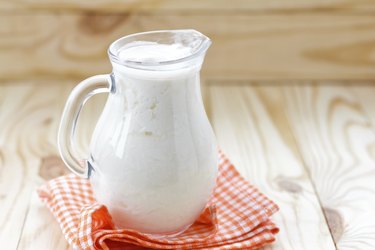
Cultured buttermilk adds a distinctive tang to baked goods, pancakes and meat marinades while also keeping food tender. You can find cultured buttermilk in the dairy section of any grocery store; it differs from old-fashioned buttermilk, a byproduct of the butter-making process. The two cannot be used interchangeably.
Cultured Buttermilk
Video of the Day
To produce cultured buttermilk, low-fat or non-fat milk must be acidified with bacteria cultures similar to those found in cream during the butter-making process. The taste of cultured buttermilk differs from traditional buttermilk, however. The sour liquid resembles yogurt, with a thicker texture than traditional buttermilk. It is used primarily for cooking rather than drinking.
Video of the Day
Old-Fashioned Buttermilk
Old-fashioned buttermilk occurs during the process used to transform cream into butter. The slightly acidic taste comes from bacteria naturally present in the cream, which is allowed to sour slightly. Old-fashioned buttermilk was most commonly added to recipes as a way to boost nutrition. Traditional buttermilk is not available for sale in grocery stores in the United States, but you might find it through specialty dairy producers. It has a rich, buttery taste and only a gently acidic tang. The thin liquid contains almost no fat, as it is removed during the butter-making process.
Substituting and Options
Because of their significant differences in taste and texture, old-fashioned and cultured buttermilk cannot be substituted for one another. In a recipe calling for old-fashioned buttermilk, you can substitute water with a small amount of lemon juice. Replace cultured buttermilk with thinned sour cream or yogurt. Mix water into the sour cream or plain yogurt to achieve the right consistency and use it as you would buttermilk.
Make Buttermilk at Home
Make cultured buttermilk at home using either a buttermilk starter or leftover buttermilk. Use a 16-to-1 ratio of buttermilk to low-fat or non-fat milk. Mix the buttermilk and milk together and store the liquid in a glass jar. Cover the jar with a coffee filter or cheese cloth to keep out debris and dust, but do not seal it with a lid. Leave the jar at room temperature, between 70 to 78 degrees Fahrenheit, and let it sit for 10 to 24 hours. When the milk moves away from the sides of the jar as a single mass, the buttermilk is ready. Seal the jar tightly and store it in the refrigerator for six hours. Stir the cultured buttermilk before using it.